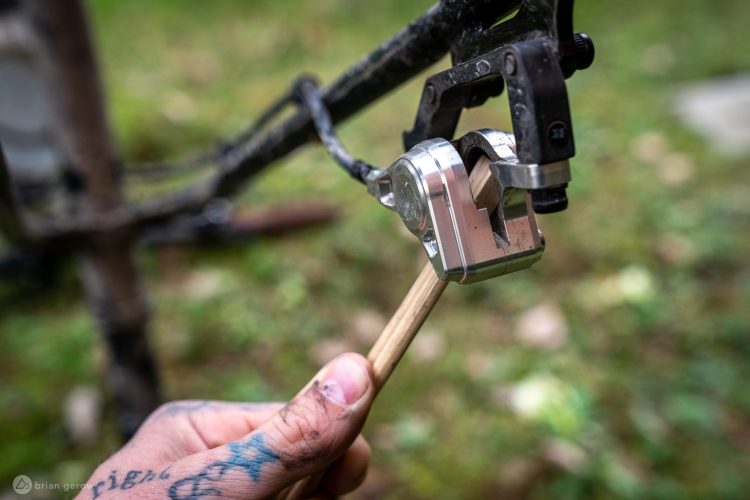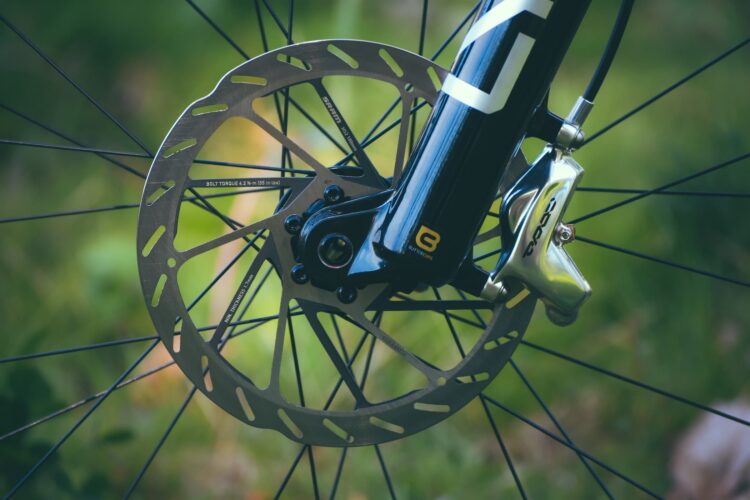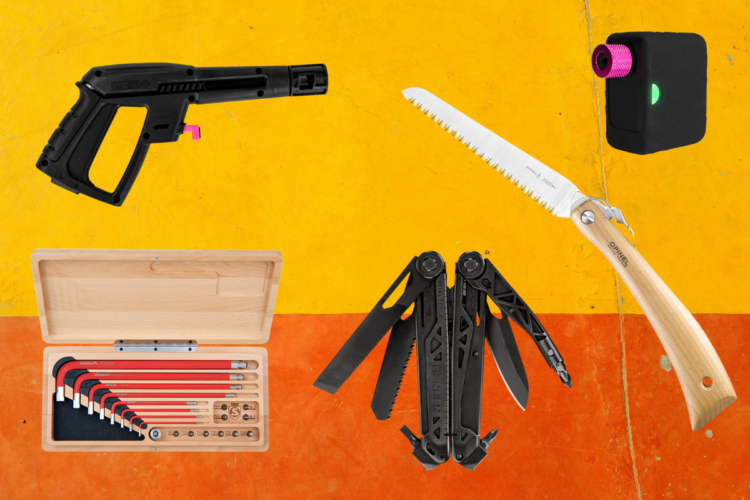
Mounting up a quality set of mountain bike brakes is like increasing the horsepower of a motorcycle engine. The more powerful the brakes are the less you have to use them, and the faster you can ride. Better brakes also improve heat dissipation, which means their power fades less on long descents where you need it most. Those higher-quality brakes are the sum of their parts, from the master cylinder to the hose to the caliper and pistons and finally the pads and rotor.
If you bought a bike with brakes that aren’t up to your speed, a larger set of rotors and some more aggressive pads can be an affordable way to improve their performance. Over the next few months, we will be testing pads from five aftermarket brands, including Galfer, Braking, Less Brakes, MTX Braking, and Trickstuff to determine how different compounds and methods change brake performance.
In the meantime, we interviewed Daryl Simmons at Galfer to get an idea of how their pads and rotors are made, and what the differences equate to out on the trail. Galfer got its start in Italy, then moved to Spain sometime in the late 1940s to early ’50s. In 1992 the son and grandson of the growing family business decided to open a branch in the US, where a majority of their business deals with Harley Davidson motorcycles. In addition to making moto and MTB aftermarket pads, Galfer is the OEM supplier of pads for both Hope and Magura, so they definitely know their stuff when it comes to pedal bikes.
We all have heard of metallic and organic/resin pads, but what are the advantages of these compounds?
Mostly for bicycle disc brakes the discussion is between organic/semi-metallic pads and sintered pads. Organic and semi-metallic are interchangeable terms. Generally, organic pads have more initial bite when braking, but an overall lower heat tolerance and longevity. Sintered pads have a higher heat tolerance and are much more durable. They have less initial bite and are more prone to being noisy especially when wet. Also since it’s a harder compound it will wear rotors more than organic. Most of our brake pads are semi-metallic, meaning they are a blend of organic and metallic material. We just change up the exact blend of materials to reach the compound’s intended goal.
How about the pad backing plate? How does that material and thickness affect performance?
We use a steel backing plate for all our bicycle brake pads. Steel is cheaper and we already have lots of knowledge on steel backing plates from the moto side. We know how to adhere to steel, we know the heat capabilities, and also the coatings that we need to apply to the steel to make sure we don’t bend the backing plates. It’s simply what’s been done and what’s always worked best.
What’s the deal with finned pads like those used in Shimano calipers? Have you found that they help dissipate heat enough to warrant the added material?
We have not found a significant performance gain by adding a heat sink to the brake pad. For the most part, it adds a little weight and we have heard from many using them that it causes the brake pads to rattle in the caliper. Many riders like a silent or very quiet bike and this rattling can be annoying.

How do you determine the perfect thickness for pad material?
Brake pad thickness is dictated by the caliper. We try to maximize the amount of brake pad in a caliper while still clearing a rotor so riders can get the most longevity out of our pads as possible.
In what ways can pads affect brake performance?
Pads are a key performance aspect of any brake system. A quality brake pad can make a world of difference in power and the feel of brakes. Depending on the compound, the actual mix of the compound, and not just the type (organic or metallic), you can achieve drastically different results. Different compounds have higher or lower heat tolerances which is a key concern for brakes. Simply every brake has a temperature that they will fail. For example, we have an e-bike specific compound with a very high heat tolerance as they’re used on heavier bikes, heavier bikes mean more heat buildup.
What changes brake pad durability?
The compound blend is the key factor in brake pad durability. Like other wear items, you get trade-offs in terms of durability and performance. For example, our Pro compound brake pads wear much quicker than our Standard compound pads, but in return, you get increased bite and power. It is the same idea as a softer rubber compound for tires will have increased grip and traction, but don’t last near as long as a tire with a harder rubber compound.

What keeps the pad stuck to the backing-plate? We have seen them rip-off before. Why would that happen?
The pad compound is initially pressed into a puck, this puck is then adhered to a backing plate using resin and cured under pressure and heat. If you look at the backing plate, holes are drilled through them and the pad material fills this space. It is very rare for the pad material to rip off of the backing plate for most everyone. This just comes down to the strength of the bond between the pad and backing plate being much greater than the shear force required to separate the two.
What helps a pad deal with water, and perform well in wet conditions?
In wet conditions, many prefer a sintered pad as it will not wear down as fast as organic pads, at least that’s a general perception. Rotor design is arguably more important as the design of a rotor can help clear water from a brake caliper.
What makes a pad quiet vs. noisy?
The root cause of any noise is vibration. The cause of any vibration is how the material of the brake pad and rotor work together. Noisy brakes can be caused by several different factors. Brakes that are too cold, too hot, contaminated, or wet can all be noisy. Having everything aligned properly (caliper centered over a rotor that spins true) is a good first step to make sure vibrations are minimized.

Why do we have so many brake pad shapes? Are there advantages to the shapes?
The main thing to consider with a brake pad shape is the total contact area of the brake pad compound with the rotor. Obviously, if your brake pad is larger than the rotor you’re just wasting material that will never contact the rotor. On the other hand, a small compound surface will leave the available surface area on the rotor that isn’t being utilized. The more contact you have the more friction and thus more stopping power.
Is there an advantage to the way the braking surface on a rotor is cut? Does the pattern matter?
Absolutely! Different cuts/designs will have different feels when braking, but past that the design can help with heat management, clearing of foreign material, and wear among other things. Our Wave® rotors have the brake track constantly moving up and down within the caliper to get the best brake pad wear while also reducing heat buildup. Past that the design of the interior cuts helps eject foreign material that may find its way into the brake regardless of if it’s dirt, dust, or water. Smaller circular holes in a rotor tend to trap more heat whereas ours are cut in non-circular shapes allow air to better travel through and remove this heat buildup.
How does rotor thickness affect brake performance?
The main reasons for thicker rotors are heat management and durability. Simply a thicker rotor has more material to handle more heat buildup and will be more durable.
How much does rotor diameter affect braking power? What’s the quantitative difference between a 180mm and 203mm rotor?
A larger rotor means the caliper is spaced further from the axle and this creates a larger leverage force on your hub slowing you down. Simply, it is more torque and power stopping you. The simplest and cheapest way to increase the power of your brake system is to increase your rotor diameter.
Any thoughts on centerlock vs. 6-bolt? Is there an advantage to one over the other?
I’m thankful that the bicycle industry majorly only has these two mounting styles, it makes it easy to service every disc brake bike. Especially when you compare this to motorcycles that have hundreds of different bolt patterns, if not 1000+. Arguably the biggest advantage or disadvantage is the serviceability which goes both ways. Centerlock is incredibly simple and quick to change out as it is just one lockring holding everything in place. Then again this does require a specialty tool to do, one that cannot really be carried easily when out riding. If a rotor gets bent while out riding say from a rock strike, it may be difficult to bend back and ultimately this may inhibit you from riding home. Compare this to 6-bolt which with a basic multi-tool you should be able to remove the rotor and ride home on one brake.

What should consumers use to clean rotors?
It is best to avoid most brake cleaners marketed towards vehicle use as they can leave a residue that will contaminate your braking surface. Simple isopropyl alcohol is a great cleaner as it evaporates quickly and does not leave any residue. In some cases, it’s a good idea to use a fine-grit sandpaper or emery cloth to scrub the rotor surface to remove prior brake pad compounds, of course after sanding clean with isopropyl alcohol.
Should rotors be cleaned between two pads of the same compound? How about different compounds?
If running the exact same compound you should be fine not starting with a fresh rotor, however, it’s never a bad idea to start with a clean rotor and properly bed in the new brake pads. When switching compounds, especially from one brand to another, the rotor should be cleaned. Not all brake pad compounds play friendly with each other so for best performance having just the brake pad compound you are going to use bedded in with the rotor is the way to go.
What makes Galfer rotors special?
Our design, the material we use, and our manufacturing process. Our history and knowledge of friction materials. Over nearly seven decades of working with performance friction materials, Galfer has a very refined process. Our rotors are made of a high carbon content 420 virgin stainless steel that is proprietary to us. The higher carbon content steel is a higher friction surface with a great memory that prevents it from warping. They are all laser cut as opposed to stamped. Stamping stresses the steel by shearing the extra material away from the rotor.
Every rotor is hand-fed into a double-disc grinder to ensure a perfectly parallel and flat braking surface. The rotors are heat-treated specifically for their intended use. Beyond the material and process, our design is well thought out to have the best wear and heat management characteristics.
Finally, what’s different about Galfer pads?
In many ways, we are working to change the narrative around brake pads with our products. The general conversation people have when upgrading their brake pads is going from the organic pads from the brake manufacturer to the sintered option also from the brake manufacturer. Our product proudly says that this is a somewhat outdated way of thinking. All of ours are semi-metallic, but they can accomplish very different results in terms of power, feel, and performance. We have something that is good for basic everyday use, an option for aggressive riding, a wet weather option, and even an e-bike specific compound.
If you have further questions about pads or rotors, or want us to add your favorite pad to the coming review, please let us know in the comments below.





















1 Comments
Apr 8, 2021